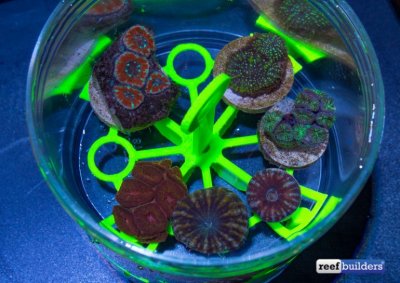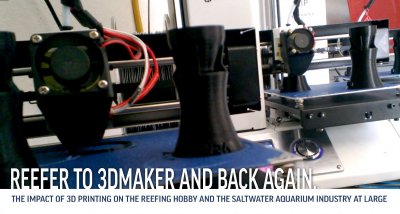This article is sponsored by @Vivid Creative Aquatics
There have been a lot of changes in the reefing hobby in just the past few years including innovations in equipment such as controllable DC pumps, LED lighting, plus computers that automate and run our tanks. Even our approach and understanding of how to create a successful reef tank has changed to some extent. But the one thing that remains constant is our desire, as reefing enthusiasts, to create something unique – something we can call our own. This is where 3D printing and reefing intersect.
3D printing, in the hands of a DIYer, can be a powerful tool that allows the creation of just about anything. And right now, 3D printing is making a huge impact in the reefing community.
But first let’s take a look at what exactly is 3D printing. In its most basic form, 3D printing is the process by which a physical object can be made from a three-dimensional digital model.
There are many different types of 3D printing from FFF/FDM (Fused Layer Deposition) to SLA (Stereolithography), even SLS (Selective Laser Sintering) to name a few. The most common and least expensive type of 3D printer is the FFF/FDM printer, which is where most hobbyists get their start.
An FFF/FDM 3D printer uses plastic filament which is heated to its melting point and then extruded, layer by layer, to create the three-dimensional object. There are many types of plastics that can be used. For 3D printed parts for use in and around a reef tank, they will generally be printed with PLA, PETG and ABS plastic, depending on the intended end use of the part.
An FFF/FDM 3D printer printing a Random Flow Generator™ Nozzle in PETG, layer by layer
OK, so now that you know what 3D printing is and how it works, how is it being used in the Reefing hobby? The answer is just about everywhere! You'll find 3D printing being used at every level from early prototyping of products by well-known manufacturers, to the hobbyist designing and printing parts to fill a specific need for their own tank. Lately, one of the most visible ways 3D printing is being used is in the area of Additive Manufacturing.
Additive Manufacturing, or AM, is where 3D printing is used to mass-produce parts that might have traditionally been created via injection molding. AM methods are also very effective where the part to be manufactured has a shape or design that makes it difficult or even impossible to manufactured using more traditional methods, such as the Random Flow Generator™ Nozzle. Additive Manufacturing techniques are very effective for short-run products but can also be scaled to produce larger quantities.
The Vivid Creative Aquatics 3D Print Facility can produce up to 380 print-hours per day.
There are a number of examples of this happening right now in the reefing community. In addition to the products that Vivid Creative Aquatics manufactures, there are other examples such as 3DReefing’s Light diffusers, and Printed Reefing Solutions array of useful brackets, holders and organizational tools.
3D printing in the Reefing hobby is not new. In fact, it has been used in this hobby for years. Just a quick search on ReefBuilders using the term “3D Print” reveals a plethora of articles and stories. These include articles about individuals and companies using 3D printing in the reefing community for at least 4 years. What is new is the wave of products being created by both individuals and companies alike.
Here’s a list of just a few of the more recent and notable 3D printed products you’ll find being offered:
Printed Reefing Solutions frag transport

TT Gadgets 3D Printed Bristleworm Trap

Random Flow Generator™ Nozzle by Vivid Creative Aquatics

PUPM Stand by Harry Singer

This is by no means a complete list because new products and examples of 3D printing for the reef tank are popping up all the time. With all this activity in the Additive Manufacturing front, the reefing industry has taken notice as well. Many of the most respected online retailers have begun to embrace products produced through Additive Manufacturing. For example, you’ll find the Random Flow Generator™ Nozzle, the NemProtect, and a whole host of other 3D printed products on sites like SaltwaterAquarium.com, Bulkreefsupply.com and MarineDepot.com
But it doesn't stop there.
3D printing is also making inroads into reef restoration and conservation. These include large-scale 3D printed ceramic and concrete structures. One example is Reef Design Lab’s 3D printed interlocking modules. These have been deployed in the Summer Islands in the Maldives under the MARS (Modular Artificial Reef Structure) project by Alex Goad.
Artificial Reef Structure) project by Alex Goad.
Another example is the artificial reef and restore project by Seaboost (Egis Group) and XtreeE
3D printed reef structures are pretty neat, and have a real potential to help turn the tide in the battle against declining reef habitat round the world. 3D printed reefscape may not just be for the ocean, however. Deven Rich of ReefDudes explored the possibilities of designing and 3D printing rock work in this awesome video.
Deven Rich exploring how fun it can be to design your own rock work in Virtual reality.
He shows that designing your own structures and printing your own rock might be possible and could even be fun. There are many Reefing hobbyists turning their love for reefing and their passion for 3D printing into a thriving community of Reefers/Makers. Take a quick read right here on Reef2Reef where there are a number of threads dealing with 3D printing. A quick search will reveal hundreds of threads.
3D printing is clearly having a big impact on the Reefing hobby and even on the industry itself. The advent of the affordable Desktop 3D printer has made it possible for just about anyone with the skills and patience to design to 3D Print to create useful equipment and accessories right at home. Additive Manufacturing has made it easier than ever to bring a unique product to market that may not have been possible or even viable before.
Here at Vivid Creative Aquatics, as an Additive Manufacturer and Reefing hobbyist, I am continually impressed with the array of ideas and products being created by the Reefing/Maker community and can’t wait to see what comes next.
Antonio Gutierrez
Vivid Creative Aquatics
~~~~~~~~~~~
We encourage all our readers to join the Reef2Reef forum. It’s easy to register, free, and reefkeeping is much easier and more fun in a community of fellow aquarists. We pride ourselves on a warm and family-friendly forum where everyone is welcome. You will also find lots of contests and giveaways with our sponsors.
~~~~~~~~~~~~
Author Profile: Antonio Gutierrez of @Vivid Creative Aquatics
My name is Antonio Gutierrez, and I own Vivid Creative Aquatics (VCA). VCA runs and maintains a manufacturing facility with over 20 3D printers. We manufacture our family of Random Flow Generator™ Nozzles and adapters but also do short-run parts and design for our customers.
Eight years ago, my daughter gave me an empty 50-gallon tank that housed her son’s pet lizard. I turned it into my first saltwater system. I was instantly hooked and never looked back. In 2015, I became increasingly interested in 3D printing allowing me to find a way to combine my two hobbies and merge them into a single endeavor. Currently I keep my 5-year-old, 125 gallon mixed reef with a 20-gallon display refugium filled with 3D printed parts and accessories.














